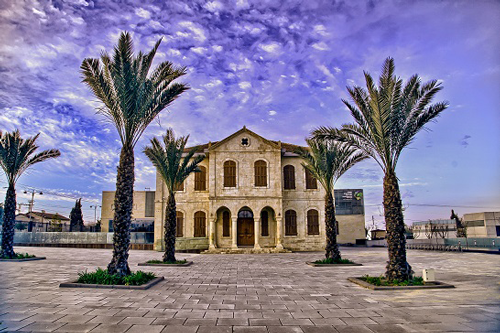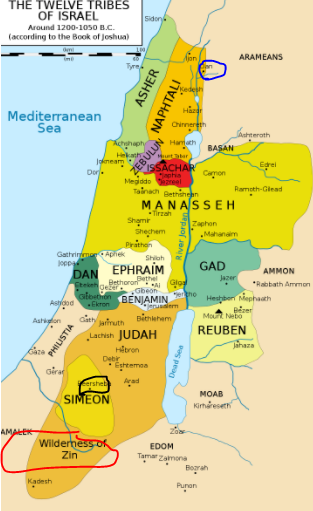“Abraham took flocks and cattle and gave them to Abimelech; and the two of them entered into a covenant. Abraham set seven ewes of the flock…Abimelech said to Abraham ‘What are these seven ewes?” … And he replied “Because you are to take these 7 ewes from me, that it may serve me as a testimony that I dug this well. Therefore, the place was called Be’er Sheva because there the two of them took an oath (Genesis 21: 27-31)”
Be’er Sheva (Beersheba) is perhaps Israel’s most underrated city for tourists to visit. Even most Israelis think of it as being “somewhere” in the desert. This city offers world-class historic and battle sites (including the last Calvary battle fought in the history of the British Empire), interactive/state of the art museums (including many kid-friendly ones), shopping, beautiful scenery, and major biblical sites, and more.

Photo Credit: https://museums.gov.il/
As a tour guide with expertise in Be’er Sheva(I have been consulted and interviewed in the media about it), I want to give you a glimpse into this “must-see” city.
Today Be’er Sheva, nestled on the edge of Israel’s Negev Desert, is one of Israel’s fastest-growing cities. There are currently 230,000 people living here, almost double the population of 20 years ago. New neighborhoods consisting of high-rise condos and small villas are being built constantly at relatively affordable prices. Due to the city’s world-renowned university and medical school, 16% of the city is made up of students, the highest per capita in the country. One-third are engineers, a fact not lost on the world’s most powerful companies who want to take advantage of these brains. Companies including Oracle, IBM, Google and Lockheed Martin are building large offices and R & D plants in the new, multibillion-dollar technological park, located in the northern part of the city. The Israel Defense Force (IDF), arguably the world leader in technological innovation, is set to move its Intelligence corps and Telecommunications /computers/ teleprocessing operations base to Be’er Sheva.
The city has become known as the “Water City” because of its proliferation of gorgeous water fountains, and a new 22.5-acre artificial lake under construction. This will be the largest artificial lake in the country, and the second largest lake overall after the Sea of Galilee.

Photo Credit: City of Be’er Sheva
This desert municipality has Israel’s best soccer team, the most shopping space per square mile in the country, and boasts more chess grandmasters than any city in the world!

Photo Credit: https://en.chessbase.com/
So much can be said about Be’er Sheva, but the biggest reason my tourists enjoy it so much is because of its rich history!
Be’er Sheva is mentioned 34 times in the Bible. The well-preserved archeological remains are a must see for Biblical enthusiasts. This was the place where Abraham, Isaac and Jacob lived and proclaimed the name of G-d (Genesis 21:33). Here, G-d appeared to Abraham telling him to bring his son Isaac to Jerusalem in order to sacrifice him (Genesis 22). In this city, Jacob received the blessing from Isaac, which incurred the wrath of Esau, prompting Rebecca to tell her son to flee from the land and only return when his brother’s anger subsided (Genesis 27 and 28).
Nine times in Tanach (the Hebrew Bible), the borders of Israel are mentioned as being from Dan (in the North) to Be’er Sheva (in the south). That is quite surprising when one reads Numbers 34:3 which clearly states that the southern border of biblical Israel is actually Nahal Tzin, about 50 kms (31 miles) further south. Why is Beer Sheva therefore mentioned as the southern border so many times? Because Beer Sheva is the southern border of “populated” Israel. In ancient times it was nearly impossible to live further south due to the extreme heat of the desert, and civilization ended here. That is why when Abraham expelled Hagar and his son Ishmael from his home, they strayed into the “desert of Be’er Sheva (Genesis 21:4)”.

Indeed, when standing at ancient Be’er Sheva one can see how just a little farther south, the extreme desert begins to take over the landscape in a dramatic fashion.

Be’er Sheva itself had ample water because the underground water table was high. One had to just dig a well and they would hit water, as Abraham and Isaac did.
When Joshua brought the children of Israel into the land, Be’er Shevawas allocated to the tribe of Shimon (Simon) (Joshua 19:2).
Later King Solomon will build Be’er Sheva as a storage city (most of the remains we visit today are from that time) and it will become the local capital of the region. The city was tiny, at only 11 dunim (2.7 Acres). Still, the urban planning was quite sophisticated.
As the provincial capital city, they collected taxes from the nearby cities. This was before actual money as we know it existed, so taxes were paid in goods such as grain, produce, oil and other commodities. In the storehouse, the names of the cities that paid taxes were found on pottery.
One of the pots said “Holy”, suggesting that everything in this pot had been designated for use in Jerusalem’s Holy Temple (see Numbers 27).
One of the more interesting rooms, the one with the “altar”, is mentioned explicitly in the Bible. Regarding Josiah, the righteous king who almost completely eradicated idol worship from the land, “He defiled the high places where…priests used to burn offerings from Geba to Be’er Sheva…The one which was at the entrance of the gate…situated at one’s left (when entering) the city gate (2 Kings 23:8)”. Indeed, when walking through the gate, the first building to your immediate left is this “high place”.


Photo Credit: Moshe David via the PikiWiki – Israel free image collection project Creative Commons Attribution 2.5 Generic
Interestingly, King Josiah was “smashing” places of idol worship in some parts of the country, while in other cases he only “defiled” them. Why did he choose to “defile” this one and not destroy it? According to Jewish sources, this particular altar was not used for idol worship, but in the service of G-d. Although this was also forbidden, since once the Temple was built, it was forbidden to do sacrifices outside of the Temple, it still had a level of holiness. Therefore, Josiah simply made it unusable by defiling them.
Perhaps the most unique feature of this site is its intricate water system.

Photo Credit: Moshe David via the PikiWiki – Israel free image collection project Creative Commons Attribution 2.5 Generic
Many of my tourists consider entering the water system to be the highlight of their visit!

Photo Credit: Mboesch – Creative Commons Attribution-Share Alike 4.0 International
There is so much more that can be said about Be’er Sheva! This article only gives a small glimpse of what there is to experience in this amazing city. On your next trip, I highly encourage you to spend a day touring here. Before you do, check this out: Be’er Sheva Sample Itinerary
Please visit the author’s site: https://guidedtoursofisrael.com
(All photos courtesy of author, public usage or licensed by author for commercial usage)






![How Your Inner Critic Is Really Your Best Friend – Soul Talk [audio]](https://www.jewishpress.com/wp-content/uploads/2025/01/landscape-4254269_640-218x150.jpg)
![Don’t Give In to Kidnappers – Political Hitman [audio]](https://www.jewishpress.com/wp-content/uploads/2025/01/chains-19176_640-218x150.jpg)



















